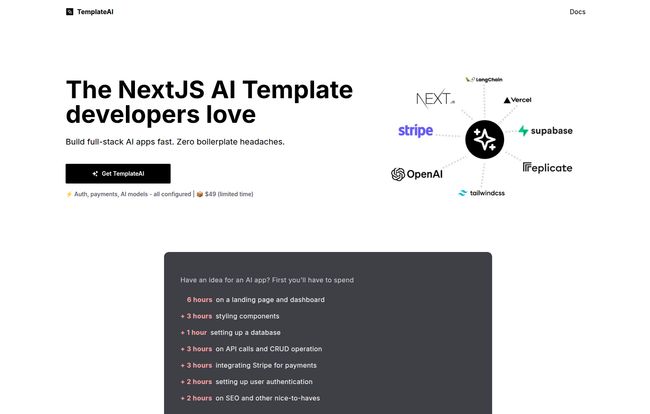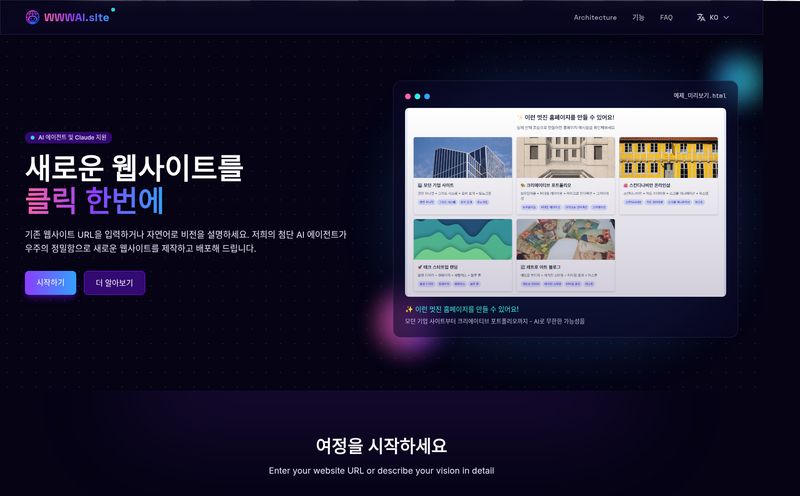You get that spark. That million-dollar (or at least, pretty-cool-SaaS-dollar) idea for a new AI application. You're buzzing. You can already see the slick UI, the mind-blowing text generation, the users flocking to your creation. It's going to be epic.
And then... reality hits. The sigh. The slump in your chair. Before you can even write a single line of AI magic, you have to build the house it'll live in. User authentication. Database setup. A landing page. Billing integration. Suddenly your epic AI quest feels more like an endless series of chores. It's the digital equivalent of needing to build a whole car factory just to test drive a new engine.
I've been there more times than I care to admit. Weeks can evaporate just getting the basic scaffolding in place. That initial excitement? It can fizzle out pretty fast. It’s a momentum killer.
That's why when I stumbled upon something called TemplateAI, my cynical developer brain perked up. The promise is simple and seductive: "Build full-stack AI apps fast. Zero boilerplate headaches." Could this be the cheat code I’ve been looking for?
So, What Exactly is TemplateAI?
In simple terms, TemplateAI is a pre-built foundation for an AI application. It’s a Next.js template that comes wired up with a whole bunch of essential technologies right out of the box. Think of it as a professional-grade starter kit for developers. Instead of starting from an empty folder, you start with 80% of the non-unique, boring stuff already done. And done well.
The tech stack is a modern developer's dream lineup:
- Framework: Next.js 13 (using the new App Router)
- Database & Auth: Supabase
- Styling: Tailwind CSS
- Payments: Stripe
- AI Integrations: OpenAI, Replicate, LangChain
This isn't some random collection of tools; it's a curated stack that works beautifully together for building and launching web apps, especially AI-powered ones.
Slaying the Boilerplate Dragon
The main sales pitch on the TemplateAI site is the time savings. They claim their template saves you around 31 hours of initial setup work. At first, I scoffed. Thirty-one hours? Sounds a bit specific, a bit... market-y. But then I looked at their breakdown:
- Landing page and dashboard: 6 hours
- Stripe integration: 3 hours
- User authentication: 2 hours
- Setting up vector search: 3 hours
...and on and on. And you know what? It's not wrong. In fact, for me, some of those might be conservative estimates. I once lost an entire weekend just wrestling with OAuth providers and webhook signatures for Stripe. A whole weekend! That’s time I could have spent actually building the core feature of my app.
This template is designed to hand you all of that on a silver platter, letting you jump straight to the fun part: building out your unique AI features.
A Look Under the Hood: The Features That Matter
A template is only as good as its parts. So let’s pop the hood and see what we’re working with.
The Frontend Framework: Next.js 13 and Tailwind
No surprise here. Next.js is the king of React frameworks for a reason, and using the latest version with the App Router means you’re building on a modern, future-proof foundation. It’s fast, great for SEO, and a joy to develop with. Pairing it with Tailwind CSS is the chef's kiss. You get a utility-first CSS framework that lets you build custom designs without ever leaving your HTML. TemplateAI comes with pre-built landing page components, dashboard pages, and even 30+ themes including a slick dark mode. That's a huge head start.
The Backend Powerhouse: Supabase Integration
If you haven't tried Supabase yet, you're missing out. It's the open-source alternative to Firebase and it’s fantastic. TemplateAI uses it for two of the biggest initial hurdles: database management and user authentication. Getting a Postgres database up and running and handling user sign-ups, logins, and password resets is all configured for you. This alone is worth a good chunk of the asking price.

Visit TemplateAI
The AI Goodies: OpenAI, Replicate, and LangChain
This is where it gets really interesting. This isn't just a generic SaaS template; it’s specifically for AI apps. It includes ready-to-use integrations for:
- Text Generation: Hooked up to OpenAI (think GPT-4) and Anthropic's Claude models. You can build chatbots, content writers, summarizers, you name it.
- Image Generation: Integrated with Replicate, which allows you to run models like Stable Diffusion to create AI images.
- Vector Search: This is a big one. It uses LangChain and Supabase's `pgvector` extension to handle vector embeddings. This is the technology behind Retrieval-Augmented Generation (RAG), which lets you create AI that can answer questions based on your own documents or data. Super powerful stuff.
Monetization Made Easy: Stripe Integration
Want to actually make money with your app? You'll need to accept payments. Anyone who's built a subscription service from scratch knows that Stripe integration is a multi-headed beast of products, plans, webhooks, and checkout sessions. TemplateAI comes with it pre-configured. A massive, massive timesaver.
Is It All Perfect? A Reality Check
Okay, so I’m clearly pretty impressed. But what's the catch? Nothing is perfect, and this template is no exception. Here are a few things to keep in mind.
First, this is not a no-code tool. You need to be a developer. You need to be comfortable with JavaScript/TypeScript, React, and the command line. If you're not familiar with Next.js and Supabase, there will be a learning curve. This template gives you a running start, it doesnt run the race for you.
Second, it's a template, not a finished product. You will absolutely need to customize it to fit your specific vision. This is a good thing—it's flexible—but don't expect to just deploy it and have a unique app. You're buying the foundation, not the fully furnished house.
Finally, it's not free. Which brings us to the big question...
The All-Important Question: How Much Does It Cost?
TemplateAI has a refreshingly simple pricing model. It's a one-time payment of $49. For that, you get lifetime access to the entire GitHub repository. No subscriptions, no hidden fees.
Let's put that $49 in perspective. If you're a freelance developer charging, say, $75/hour, that 31 hours of boilerplate work the template saves you is worth over $2,300. Even if you're a hobbyist who values their time at a modest $20/hour, that’s over $600 of your time. So, paying $49 to skip all that... it's kind of a no-brainer. It's less than a fancy dinner out.
My Honest Take: Who is TemplateAI Really For?
After digging through it, I have a pretty clear idea of who would get the most out of this.
TemplateAI is an absolute godsend for:
- Indie Hackers & Solopreneurs: If you're a one-person army trying to launch an AI SaaS, your most valuable resource is time. This template buys you a significant amount of it.
- Startups & Small Teams: Perfect for building an MVP (Minimum Viable Product) and validating an idea quickly without burning through your runway on setup tasks.
- Developers Exploring AI: If you want to build a cool AI project for your portfolio but get bogged down in the full-stack setup, this is your fast track.
Who is it not for? Probably not for absolute beginners who have never touched React or a backend service before. And likely not for large enterprises that have their own established, rigid tech stacks and design systems.
Final Thoughts
In a world where new AI models and possibilities pop up every week, speed is the ultimate advantage. The difference between launching now and launching in six weeks can be huge. Tools like TemplateAI are more than just conveniences; they are accelerators. They demolish the most common barriers to entry and let creators focus on what they do best: creating.
It's not magic, but it's the next best thing: a well-thought-out, high-quality head start. If you have an AI app idea simmering on the back burner, this might just be the thing that helps you finally serve it up.
Frequently Asked Questions
- What do I get exactly when I buy TemplateAI?
- You get lifetime access to a private GitHub repository containing the complete source code for the Next.js 13 template. This includes all the features mentioned: frontend components, database and auth setup, Stripe integration, and the AI model connections.
- What kind of applications can I build with this?
- Pretty much any full-stack AI application you can think of. Examples include AI-powered writing assistants, chatbot SaaS products, AI image generation platforms, tools for summarizing documents, or any app that needs a user login, a database, and AI capabilities.
- Does this use the latest version of Next.js?
- Yes, it's built on Next.js 13 and uses the modern App Router, not the older Pages Router. This ensures you're starting with the latest and greatest from the Vercel team.
- What is your refund policy?
- According to their site, due to the nature of digital products (you get the full code immediately), they generally do not offer refunds. It's a standard policy for this type of product.
- What if I run into a problem during setup?
- The template comes with documentation to guide you through the setup process. For specific issues, you would typically raise an issue on the private GitHub repository where the community or the creators can assist.



